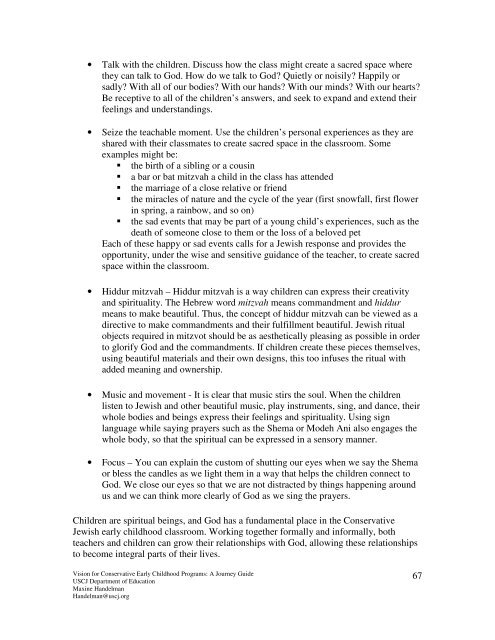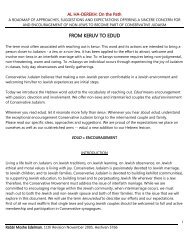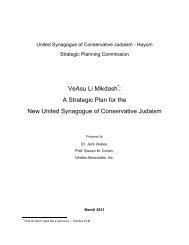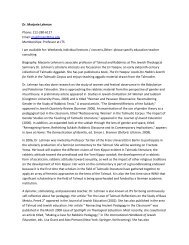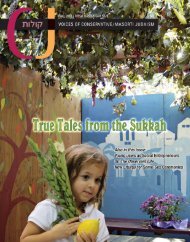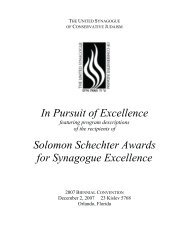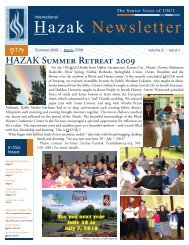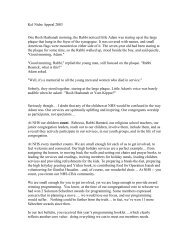Vision for Conservative Early Childhood Programs: A Journey Guide
Vision for Conservative Early Childhood Programs: A Journey Guide
Vision for Conservative Early Childhood Programs: A Journey Guide
You also want an ePaper? Increase the reach of your titles
YUMPU automatically turns print PDFs into web optimized ePapers that Google loves.
• Talk with the children. Discuss how the class might create a sacred space where<br />
they can talk to God. How do we talk to God? Quietly or noisily? Happily or<br />
sadly? With all of our bodies? With our hands? With our minds? With our hearts?<br />
Be receptive to all of the children’s answers, and seek to expand and extend their<br />
feelings and understandings.<br />
• Seize the teachable moment. Use the children’s personal experiences as they are<br />
shared with their classmates to create sacred space in the classroom. Some<br />
examples might be:<br />
the birth of a sibling or a cousin<br />
a bar or bat mitzvah a child in the class has attended<br />
the marriage of a close relative or friend<br />
the miracles of nature and the cycle of the year (first snowfall, first flower<br />
in spring, a rainbow, and so on)<br />
the sad events that may be part of a young child’s experiences, such as the<br />
death of someone close to them or the loss of a beloved pet<br />
Each of these happy or sad events calls <strong>for</strong> a Jewish response and provides the<br />
opportunity, under the wise and sensitive guidance of the teacher, to create sacred<br />
space within the classroom.<br />
• Hiddur mitzvah – Hiddur mitzvah is a way children can express their creativity<br />
and spirituality. The Hebrew word mitzvah means commandment and hiddur<br />
means to make beautiful. Thus, the concept of hiddur mitzvah can be viewed as a<br />
directive to make commandments and their fulfillment beautiful. Jewish ritual<br />
objects required in mitzvot should be as aesthetically pleasing as possible in order<br />
to glorify God and the commandments. If children create these pieces themselves,<br />
using beautiful materials and their own designs, this too infuses the ritual with<br />
added meaning and ownership.<br />
• Music and movement - It is clear that music stirs the soul. When the children<br />
listen to Jewish and other beautiful music, play instruments, sing, and dance, their<br />
whole bodies and beings express their feelings and spirituality. Using sign<br />
language while saying prayers such as the Shema or Modeh Ani also engages the<br />
whole body, so that the spiritual can be expressed in a sensory manner.<br />
• Focus – You can explain the custom of shutting our eyes when we say the Shema<br />
or bless the candles as we light them in a way that helps the children connect to<br />
God. We close our eyes so that we are not distracted by things happening around<br />
us and we can think more clearly of God as we sing the prayers.<br />
Children are spiritual beings, and God has a fundamental place in the <strong>Conservative</strong><br />
Jewish early childhood classroom. Working together <strong>for</strong>mally and in<strong>for</strong>mally, both<br />
teachers and children can grow their relationships with God, allowing these relationships<br />
to become integral parts of their lives.<br />
<strong>Vision</strong> <strong>for</strong> <strong>Conservative</strong> <strong>Early</strong> <strong>Childhood</strong> <strong>Programs</strong>: A <strong>Journey</strong> <strong>Guide</strong><br />
USCJ Department of Education<br />
Maxine Handelman<br />
Handelman@uscj.org<br />
67


